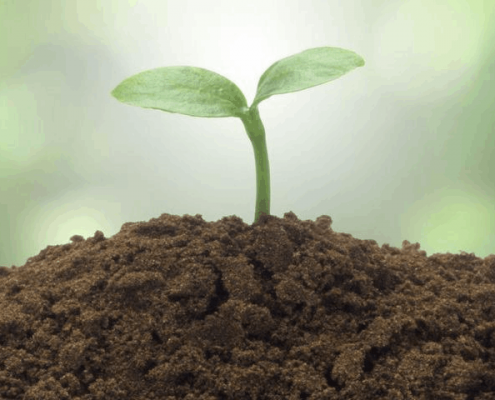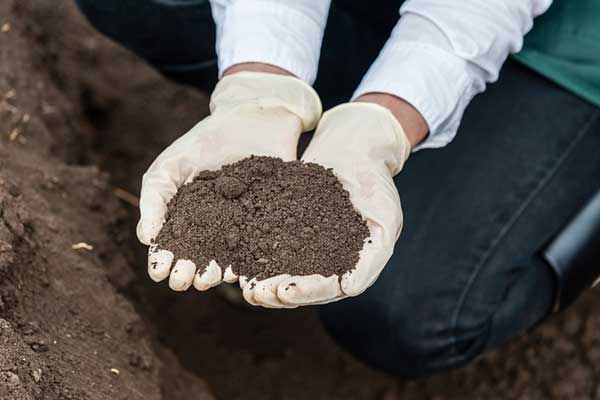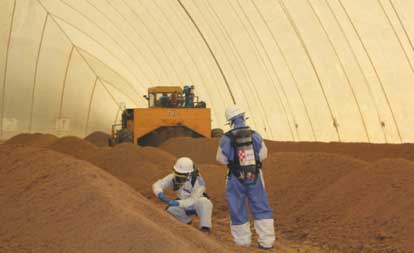Soil pollution refers to the phenomenon that pollutants generated by human activities enter the soil and accumulate to a certain extent, causing the quality of the soil to deteriorate and the function to decrease.
After the land is contaminated, topsoil with a high concentration of pollutants easily enters the atmosphere and water bodies under the action of wind and water. These pollutants eventually affect human health through the food chain.
Direct manifestation of soil pollution to human harm
1. Lead to reduced crop production and reduced quality of agricultural products;
2.Contaminated groundwater and surface water;
3.Affect the quality of the atmospheric environment;
4. Endanger human health.
Soil remediation process

1.Physical repair technology
(1) Soil steam extraction and repair technology
Soil steam extraction and repair technology is to introduce clean air into the contaminated soil to generate driving force, and use the concentration gradient between the solid phase, liquid phase and gas phase of the soil to convert it into a gaseous pollutant and discharge it when the air pressure decreases. process.
This technology is suitable for the remediation of soils polluted by high volatile organic compounds and some semi-volatile organic compounds, such as those contaminated by gasoline, stupid and tetrachloroethylene.
(2) Vitrification repair technology
Vitrification repair technology refers to the use of thermal energy to melt solid pollutants into glass-like or glass-ceramic-like substances at high temperatures, and to make the solidified body permanently stable by virtue of the dense crystalline structure of the glass body. After the vitrification of the pollutants, the organic pollutants will be destroyed by pyrolysis or converted into gas to escape, and the radioactive substances and heavy metals in them will be firmly bound in the molten glass. The vitrification repair technology is suitable for both in-situ processing and ex-situ processing.
(3) curing / stabilizing technology
Solidification / stabilization technology refers to the use of physical or chemical methods to fix harmful pollutants in the soil, or to convert pollutants into inactive forms of chemical substances, preventing them from migrating and spreading in the environment, thereby reducing pollution Remediation technology for the degree of substance poisoning.
This technology is usually used for the harmless treatment of soil contaminated by heavy metals and radioactive materials, but subsequent use of the site after repair may cause aging or failure of the solidified material, which affects its curing ability. Contact with water or icing / thawing process will reduce pollution Effects of objects.
(4) Electrodynamic repair technology
Electrokinetic repair technology is to apply direct current (several amperes per square meter) to the soil, under the combined action of point solution, electromigration, diffusion, electroosmosis, electric pulses, etc., to enrich the ions in the soil solution near the electrode, thereby Reach the process of removal.
The target pollutants of this technology include most inorganic pollutants, radioactive materials and organic substances with strong adsorption. The electrokinetic repair speed is fast and the cost is low. It is especially suitable for the repair of contaminated soils with a wide range of viscous metals and soluble organic matter. For insoluble organic sewage, chemical solubilization is required and secondary pollution is easy to occur.

(5) Thermodynamic repair technology
Thermodynamic repair technology refers to the process of removing or destroying toxic substances in the soil by using some physical and chemical effects generated by high temperature, such as volatilization, combustion, pyrolysis.
This technology is often used to treat organically contaminated soils, such as volatile organics, semi-volatile organics, pesticides, and high-boiling chlorinated compounds. It is also suitable for partially contaminated soils such as volatile metal mercury. But heat treatment technology is not applicable to most inorganic pollutants, corrosive organics, active oxidants and reducing agents.
(6) Guest soil and soil exchange technology
Guest soil refers to covering contaminated soil with non-contaminated soil to prevent pollutants in the contaminated soil from entering the food chain. However, the incoming clean soil layer needs a certain thickness, which can meet the growth of plant roots to prevent it from reaching the polluted soil layer. Soil replacement is to remove some or all of the contaminated soil and replace it with non-contaminated soil. Practice has proved that this is a practical and effective method for controlling soil pollution, especially heavy metal pollution. In general, the greater the thickness of soil replacement, the more significant the reduction of pollutant content in the crop.
2. Chemical repair technology
(1) Chemical leaching technology
Chemical leaching technology refers to the use of eluent or chemical additives to combine with pollutants in the soil, and through the desorption, chelation, dissolution or fixation of the eluent to make the pollutants adsorbed or fixed on the soil particles Desorption, dissolution and removal technology.
Chemical leaching technology can be divided into in situ leaching technology and ectopic leaching technology. In-situ leaching technology is suitable for both inorganic and organic pollutants, especially for the remediation of soil pollution with coarse texture and strong permeability; ectopic leaching technology can be used for radioactive materials, organic or mixed organics, heavy metals Or other inorganic matter contaminated soil before processing.
(2) In-situ chemical oxidation technology
In-situ chemical oxidation technology refers to the repair technology that injects chemical oxidants into the soil to oxidize the pollutants in it to degrade or convert the pollutants into low-toxicity and low-mobility products. The chemical oxidation technology does not need to excavate all the contaminated soil, but only drills in different plans of the polluted area, and then pumps the oxidant into the soil through a pump.
In situ chemical oxidation technology is often used to repair pollutants such as oils, organic solvents, polycyclic aromatic hydrocarbons, POPs, pesticides, and water-insoluble chlorides that have been in the soil for a long time and are difficult to biodegrade.

(3) Chemical dehalogenation technology
Chemical dehalogenation technology refers to adding reagents to the soil contaminated with halogenated organics to replace or replace halogens in pollutants or to decompose or partially volatilize and remove them. It is one of the ectopic chemical repair technologies.
This technology is suitable for treating volatile or semi-volatile organic pollutants, halogenated organic pollutants, polychlorinated biphenyls, dioxins, furans, etc. It is not suitable for semi-metallic halogenated organic pollutants and heavy metals, polycyclic aromatic hydrocarbons, herbicides, pesticides , Explosives, asbestos, cyanide, corrosive substances, non-halogenated organic pollutants, etc.
(4) Solvent extraction technology
Solvent extraction technology is a technology that uses solvents to extract or remove harmful chemicals from contaminated soil. This technology is mainly applicable to the treatment of volatile and semi-volatile organic pollutants, halogenated or non-halogenated organic pollutants, polychlorinated biphenyls, dioxins, furans, polycyclic aromatic hydrocarbons, herbicides, pesticides, explosives, etc.
(5) Soil performance improvement technology
Soil performance improvement technology refers to engineering techniques that take targeted modifiers or artificially change soil oxidation-reduction potential. Soil performance improvement technology is mainly aimed at heavy metal contaminated soil, and some measures can also be used to improve organic contaminated soil.
3.Microbial repair technology
(1) Principle of microbial remediation of heavy metal contaminated soil
There are many kinds of soil microorganisms, and they are huge in number. They are active organic colloids in the soil, which are larger than the surface, have a strong charge, and have vigorous metabolic activities. Microbes can fix, move, or transform heavy metals in the soil, change their environmental chemical behavior in the soil, and promote the detoxification or reduction of toxicity of toxic and harmful substances, thereby achieving the purpose of bioremediation.
Therefore, the principle of microbial repair of soil contaminated by heavy metals mainly includes biological enrichment (such as bioaccumulation and biosorption) and biotransformation (such as biological redox, methylation and demethylation, and the dissolution of heavy metals and organic complex coordination degradation). ) And other modes of action.
(2) Principles of microbial remediation of organic contaminated soil
Most organic pollutants in the soil can be degraded and transformed by microorganisms, reduce their toxicity or render them completely harmless. The degradation of organic pollutants by microorganisms mainly depends on two modes of action:
① degradation by extracellular enzymes secreted by microorganisms;
② After the pollutants are absorbed into the cells by microorganisms, they are degraded by intracellular enzymes.
Microorganisms degrade and transform organic pollutants in soil, usually rely on the following basic reaction modes to achieve.
Oxidation: alcohol oxidation; aldehyde oxidation; methyl oxidation; oxidative dealkylation; thioether oxidation; peroxidation; benzene ring hydroxylation; aromatic ring cleavage; heterocyclic cleavage; epoxidation, etc.
Reduction: Reduction of vinyl; reduction of ortho alcohol; hydroxylation of aromatic ring, etc.
Gene transfer: decarboxylation; dehalogenation; dehydrocarbonation, etc.
Hydrolysis: mainly includes the types of hydrolysis of esters, amines, phosphates and halogenated hydrocarbons.
4. Phytoremediation technology
Phytoremediation technology refers to an emerging pollution environmental treatment technology that uses the mechanism of absorption, volatilization, transformation, and degradation of plants and their rhizosphere microbial systems to clarify pollutants in the environment.


